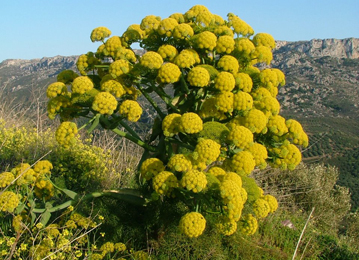Hingu (Ferula Asafoetida)

Description of Plant
Ferula is perennial, herbaceous, monoecious plant of apiaceae family. This plant grows up to height of 2mts and circular mass of leaves is 30-40cm. Leaves of this herb are very fine and flowers are yellow colored. Roots are very massive, thick and pulpy and all parts of the plant smell very fetid and unpleasant odor. Just before its flowering season, stalk of the plant cut close to the roots and from these cuttings a milky substance oozes out, which dries to form resin. This procedure lasts for three months from the first incision. In this time the plant yields more than two pounds of resin. Fruits are flat, thin, oval and reddish brown in color. Plant of asafetida is self - fertilizing and has both male and female flowers that are pollinated by means of insects.
General Information
Asafetida is common name of this herb and this name comes from Latin word "foetid" that means very smelly. It is acrid and pungent herb with very unpleasant odor. Food of the God, asant, stinking gum, devil's dung, hing, hingu, ting and kayam all are common names of this herb. Hing is resin, a gum like material and it is exuded by cutting the living rhizome and tap roots of the various species of ferula. Asafetida as its name suggests this herb has fetid smell and bitter taste. In Ayurveda hing is used for its versatile medicine properties. This herb is used as spice for kitchen and it is best used as digestive aid. In kitchen this herb is used for preparing curries and pickles. It has very strong aroma in its purest form.
There are two main varieties of hing which are available i.e. lal hing (red hing) and hing kabuli saffed (milky white hing). Red variety of hing is oil soluble while milky white is easily soluble in water. Pure form of hingu is not preferred as its processed powder and tablet form is available for use.
In roman times it was popular food and called food of gods.
Habitat
Asafetida is mainly native to Iran, Pakistan and Afghanistan and this herb is exported to all parts of world. in India it is wildly grown in Kashmir.
Classification
- Kingdom - Plantae
- Family - Apiaceae
- Order - Apiales
Names
- English name - Devil's dung, Food of god
- Hindi name - Heeng, Hing
- Telugu name - Inguva
- Bengali name - Hing
- Kannada name - Hingu
- Marathi name - Hing
- Gujarati name - Badharani
- Tamil name - Perungayam
- Malayalam name - Rungayam
- Farsi name - Rungayam
- Farsi name - Angajah, Angoj
- Arabic name - Hilteel
- French name - Assa foetida, Ferulr perisque
- German name - Asafotida, Stinkender asant
- Italian name - Assafetida
- Spanish name - Asafetida
- Afghan name - Kama-i-anguza
- Turkish name - Seyan tersi
Ayurvedic Properties
| Hindi / Sanskrit | English | ||
| Rasa | Katu | Taste | Pungent |
| Guna | Laghu, Snigdha, Teekshan | Physical Property | Light, Unctuous, Piercing |
| Virya | Ushna | Potency | Hot |
| Vipaka | Katu | Metabolic Property (After Digestion) | Pungent |
Effects on Doshas
It balances kapha and vata dosha.
| Charak Samhita | Sushrut Samhita | Vagbhata |
|
|
|
Ancient Verse about Ferula Assafoetida
हिङ्गु वातकफानाह शूलघ्नं पित्त कोपनम्॥१५२॥
कटुपाकरसं रुच्यं दीपनं पाचनं लघु ।
हिङ्गु शूलप्रशमनं विद्यात् पाचनरोचनम् ||२९९ ||
It states that hingu is used to pacify vata and kapha dosha, it increases pitta dosha and used to relieve abdominal pain. This pungent herb is light to digest, stimulates digestive fire and used as appetizer.
Hingu is carminative, palatable and used to relieve abdominal colic.
Practical uses of Ferula Assafoetida
- It is an amazing spice for treating stomach ailments. It is antispasmodic and used to cure abdominal pain, intestinal problems, flatulence, upset stomach, worm infestation and irritable bowel syndrome.
- Being anti-inflammatory, anti-viral and antibiotic in nature and it is used to cure 7various ailments like asthma, cough, common cold, whooping cough and various respiratory disorders. It acts as stimulant for respiratory tract and helpful to expel out extra phlegm and chest congestion from body.
- It is boon for female health and helps to relieve menstrual pain and used to cure heavy menstrual blood flow and irregular menstruation. It is used to boost progesterone hormone and provides a smooth menstrual blood flow.
- Headaches and migraines are very common problem in today's busy schedules. Hingu is used to reduce inflammation of blood vessels and used to relieve headaches.
- Asafetida also has abortifacient properties and it is used to induce abortion.
- It is also used as antidote for opium.
- Hing contains high amount of coumarins which are used to reduce blood clotting. This herb is anti-coagulant in nature that helps body to fight against high cholesterol levels and very helpful in reducing high blood pressure level.
- It helps to stimulate nervous system and used to cure various disorders like syncope, hysteria and convulsions.
- Hing is very powerful anti-oxidant and protects body from the effect of various free radicals. This herb helps pancreas to secrete more insulin and helps to reduce high sugar levels.
- Hing is used to pacify vata and kapha dosha.
Part used
- Resins
- Oil obtained from resins
- Arial parts - stem, leaves and flowers
Dosage
- Powdered resins - 0.3 to 1gm
- Tea - 1-2 cups
- Tincture - ½ to 1 teaspoon daily
Ayurvedic Products from Ferula Asafoetida
Caution
- It is not indicated during pregnancy because induces abortion.
- Excess of intake causes swelling of lips, nausea, vomiting and burning sensation.
- External use may cause irritation and skin rashes.



